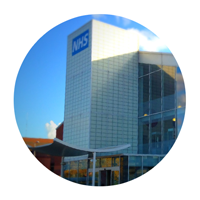Pre-Operative Clinic
Facilities on the ward include a Pre-Operative clinic, where individual patient assessments are carried out prior to coming into hospital for elective surgery. This is essential as it can pick up on any potential problems which may not be evident and which could, if not treated, result in a cancelled operation.
Recovery After Hysterectomy
It is normal during the first 24-36 hours after your surgery to experience many aches and pains all over your body. It is usual to experience backache, shoulder pain and a stiff neck as well as abdominal pain.
You may find you are attached to a PCA (Patient Controlled Analgesia), this is usually Morphine. This means you are in control of your own pain relief. Alternatively you may be attached to an Epidural infusion.
During your operation, you may have been catheterised. This means that straight after the operation you do not have to worry about going to the toilet to pass urine; this will be simply passed into a bag at your side and emptied when necessary by the nurses. It will probably be removed after the first 24 hours and removal is painless.
You will also return from your operation with an Intravenous Infusion (a drip). This is in order to maintain hydration/prevent dehydration. As soon as you return to your normal intake of fluids, the drip will be removed.
Occasionally, not always, following a hysterectomy, it is necessary to insert a ‘Drain’. This is to drain away any excess blood which may collect in the area which has been operated on, and is usually removed 24-48 hours post operation.
You may experience feelings of nausea. Anti sickness medication will have been prescribed by the anaesthetist and the nurse looking after you will make sure it is administered when you need it.
As with all major operations, it is important that you do regular deep breathing exercises in order to prevent complications such as a chest infection. Equally important are regular leg exercises to prevent Deep Vein Thrombosis, which is why we aim to restore you to full mobility as soon as possible. (You will probably be out of bed by Day 2.) We have a leaflet explaining all the necessary exercises, please ask the nurse looking after you for one of these.
You may have some slight vaginal bleeding; this is normal and should soon clear up.
A mild laxative can help to prevent you becoming constipated. You may also experience a feeling of ‘trapped wind’ due to lack of movement; having peppermint water and/or gentle exercise can normally relieve this.
An average hospital stay is between 3-5 days depending on how quick you recover and how much support you have at home.
When discharged, if you require a sick note please ask the doctor who is discharging you.
Once you return home, you must make sure that you take things easy. You must continue to do your regular exercises which you started whilst in hospital and wear your Anti-Embolism stockings (Teds) for 4 weeks at night time and if you have a lie down in the afternoon.
You should not be lifting anything heavy, such as shopping, it is therefore important that you have support at home.
It is normally around 6 weeks before patients think about a return to work; however this will depend on the type of work you do.
You should refrain from driving for about 6 weeks or until you have had your out- patient ‘check up’ appointment. This is in order to rest the abdominal muscles affected by your operation.
A little back ache, discomfort in the abdomen, are common for the first few weeks following surgery. If you have a browny discharge this should change to creamy white. You may also notice that the stitches are passed out of the body as well.
If you experience an increase in pain, pus, fresh blood or smelly discharge, you should contact your doctor as soon as possible.






